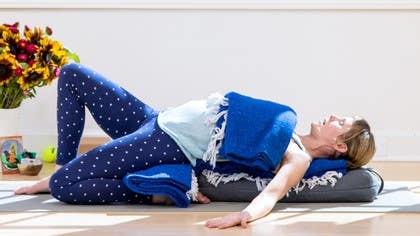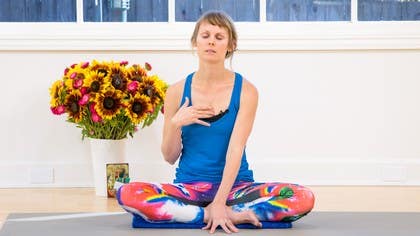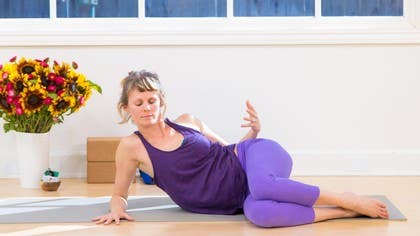Description
About This Video
Transcript
Read Full Transcript
Hi, thanks for being here. In this sequence, we will be working with this idea of letting go by Raguya in Yoga speak, and what we'll be practicing is an essence of dying a little every day. One of the impediments to joy or to bliss, as described by the Yoga Sutras, is Apinavesh, or this fear of a change in the status quo, sometimes translated as a fear of death. And one of the ways that we can work with this potential impediment to fully steeping ourselves in our true nature is to practice dying a little every day. And this happens over and over and over throughout our lives.
We die various little deaths, little ego deaths. For example, I'll give you a personal example from my own life, I used to be a lawyer. I used to be an attorney and moved through the world a certain way because of that story that I was playing out, or that identity, or that job that I had. And when I stopped doing that work, when by choice I let go of that part that I was playing, with it there was an ego death, there was the part of me that enjoyed being associated with a certain title that died, and there was a part of me that had gotten used to making a certain living and being able to do certain things with my income that died a little too. And it was such an important part or aspect of my personal practice because in that moment like oh, I had so many opportunities to die to these stories that were no longer true, to die a little every day.
And in that death, there's a rebirth to what is true, to what is now, to what is eternal and has nothing to do with what kind of job you have or what kind of car you drive or how fancy your yoga pants are. So I'm here to tell you that this kind of practice is hard, but it is so worth it. I'm glad you're here, I'm going to practice dying a little. For this practice, which will be restorative, we need some props. I have two tennis balls, these are just regular tennis balls, you can use therapy balls if you have those, or if you have children's tennis balls which are a little bit larger and a little less inflated, those are a little easier on the body.
Two tennis balls, two blocks, in place of blocks if you don't have two, always feel free to substitute like a Harry Potter book or infinite jest or something like that. Three blankets and a bolster, also at home if you don't have matching blankets that's okay and if you don't have a bolster use a couch cushion or another folded blanket. But that is our arsenal of props for today. We will begin on the belly in Saturday morning cartoon TV watching pose. And so what we'll do is belly down, stack the hands and you might rest one cheek on the back of your top hand.
You might also rest the forehead there if it feels better to you. And in time we'll bend at the knees. So this is the pose, you can imagine that if you were watching cartoons on Saturday morning you might have your chin resting on the back of the hands watching Smurfs or something. But for our purposes we're relaxing, we're yielding to what is actually happening which is gravity that is pulling us to earth. And you might close your eyes here and just sort of settle in.
Beginning with the feet, soften, let the feet become a little more liquid like in their constitution and let that essence of water or liquid sort of drop down into the backs of the knees. And let that watery liquidy essence sort of move up the legs into the lowest part of your back into the sacrum. Let the front of the pelvis and the belly get really watery. And relax any gripping that you might be doing through the creases of the hips. Let that liquid watery sense sort of collect at your heart.
And move into the shoulders. Let the rise and the fall of your body with your breath. If you've been resting one cheek or one temple on the back of your hands you might switch now if it's comfortable to do. And use that as an opportunity to sort of recommit to the softness of the shoulders and the softness in the throat and the jaw. Where are you holding?
Where are you gripping? Where are you resisting death? And so over the course of the next couple of breaths we will toy with the idea of moving from this shape. So you might wiggle your hips from side to side. Wiggle your toes.
Lift the head. Extend the legs fully and you might even tuck the toes under. Press the balls of the feet into the floor and lift the knees. Untuck the toes. Bring the hands to either side of the chest and come on up.
Now for our second shape we will practice child's pose with lots of props. So you might like to take one blanket up in front of the face, a bolster between the legs and depending on how much grounding feels appropriate you might use another blanket on the low back or even on the back of the head. And so we're sitting on our bolster or our couch cushion, hinging from the hips, letting the forehead rest on the blanket and then find the position for the arms, hands and fingers that works best. Sometimes it's nice to bring them overhead. Lately I really enjoyed bringing the hands to the back of the head, bending at the elbows and letting gravity sort of pull the hands into the base of the skull.
Give yourself lots of space, lots of time to settle into the gravity that's already happening. Notice those parts of the body where you're holding or where you're gripping or trying to get anywhere. You might go to them with all of your compassion. The yoga sutras also say it's totally normal to fear change, even the master yogis can fear change and can fear death. So if you're in that camp or if you're in that moment of feeling it, all is not lost, you're normal.
You might notice the play between your body and the breath. The rise and the fall, the squeeze and the release. Notice where your awareness sort of settles in the body. And in time we'll start to move from this place and can we move out of the pose or can we wane with as much sensitivity as we moved into the pose? You might release your arms from wherever they are.
Take in a deep breath or two and slowly start to lift up and saunter out. Pause and notice what you feel. Now the shape I'm in right now is almost exactly where we're going for our next shape. I'm just going to add a couple more props. Lift up, move your bolster behind you, keep at least two blankets nearby and take one block, place it between the feet.
Sit back, check in. For some people this is enough. For other people, like myself, it's nice to have another blanket there. Nice release through the creases of the hips. And then depending on how much you want to ground, add a blanket.
This can also be really nice to give the hands a little shelf to rest on. And we'll be here in Vajrasana for a couple of breaths, the thunderbolt. Begin by inviting the sitting bones to really settle in, to sink into what's supporting them, to let the tailbone be attentive to gravity. And as you do that, you might feel a release across the front of the hips. Relax into the elegance of your own spine.
Relax into the smoky truth of the back of the body. Notice those places where there's a temptation to grip and see if you can just invite them to sag. Don't worry if it looks like you're slouching or if you think it looks like you're slouching. And so from here, from this shape, Vajrasana, we will move toward reclining Vajrasana or Supta Vajrasana, and you may require additional props. You may pad your bolster behind you with a blanket and you might start to shimmy that closer to your tush.
You might add another blanket on top of you from here and slowly begin to meander back. Now the idea is effortlessness. So if you feel your way into this and there's pinching somewhere or there's gripping somewhere, come up and out and adjust. You can add more props behind you. You could remove the block from under your tush.
Another variation here is what I like to call the psoas air guitar. And so for this, you would take maybe your left foot to start and bring it flat to the floor before reclining. And I really like to bring the blanket up over the chest here, but people also like to bring it down low on the belly. Do what feels best to you. If you're working with the air guitar, you might press the left foot into the floor as you slightly tuck the tailbone, just like a hint of a whiff of a tuck and then release.
And you might let that happen just a couple of times before you settle in, relaxing all of the effort. Shoulders soften, throat softens, heart softens. Kindly soften. And whenever it occurs to you to go to the parts of your body where it seems as though there's something to work on or something to do, go to those parts with all of your compassion and invite softness to move into those spaces. And so if you're working with the air guitar version of this, you might, before switching sides, sort of bust out your best air guitar.
And sound like a cat. And then use your props to pull yourself up. I did win an air guitar contest once. True story. Switching feet, bringing the right foot to the floor, coming down slowly, situating your top blanket, situating your arms, hands and fingers. And then for a couple of breaths, pressing the right foot into the floor, teeny weeny little tuck of the tailbone, just ever so slight. Relax the effort. And then relaxing effort completely. Softening into what is.
When we practice this idea of dying to a story that's no longer true, we open ourselves up for mystery and magic that we couldn't even have imagined. This is very much a waning or a new moon type of a feeling in the body, like potential. We have to die to be born. And if you're working with the air guitar, you might bust out some sick air guitar moves. And then slowly start to hoist yourself up.
If you have a little person around your house or a partner, they can help you up. And then once you're up, just pause again for a moment, like just sitting, noticing what happened. Noticing the results will come up and out of the shape. And we'll move some of our props out of the way. We'll move blankets out of the way, blocks out of the way.
What our bolster is here to stay, that rhymed and I didn't even mean for it to. We'll come to table with the bolster just sort of cozied up to the knees. And then we'll recline. We'll just drop the belly onto the table, onto the bolster, lower the elbows to the floor, soften at the heels. My heels are separating here. Let the heart sag between the shoulders and your gaze might drop. I'm going to invite the soles of the feet to get really soft, really smoky.
And the backs of the knees soften. And the tailbone and the sacrum soften. Back of the heart softens. Space between the shoulders. Press the palms into the floor, lift the heart and the head slowly, pause here.
Walk the hands back so that you can press back into table. Move your bolster out of the way, but grab one of your tennis balls or whatever other kind you're working with. We'll move toward pigeon, Nikapada Kapatasana. We'll slide the left knee forward just nice and easy. Tuck the right toes under, move the right knee back in space as you slowly scooch that left foot in the general direction of the right hand. Don't worry about this front shin getting to be parallel with the top of the mat, sort of settling into the square-ish hips. And we'll take this ball and place it right underneath your keister, your booty, your hunch, whatever synonym for booty you like. And you might here sort of roll around until you find a spot that could use your attention. And when you find it, you'll know it. And slowly start to lower down.
Saunter in, saunter out, nice and easy, nice and slow. There's never any rash. And once you're in a shape, let it be, I know we're practicing dying, but let it be a living shape. So you're breathing, your body moves as you breathe. Right now, as we are here practicing, your body is regenerating itself and there's movement happening everywhere. So let yourself, you know, be free to move, not rigid, fluid, adaptable. And you might start to notice sort of this expanse that is the back of the body, vastness of the back of the body. And over the course of the next handful of breaths, we'll start to mosey out of this shape, sort of, you know, taking our time coming up. You know, you might sort of roll around on that ball a little bit more, tucking the right toes under, lifting the hips just enough to move the ball out of the way. And then moving to table. And, you know, if there's another shape here that your body wants to make, then make it between sides. Pigeon is one of those clarifying poses, you know, like usually there's something after pigeon that your body wants to do.
I could do that. And in time, we'll move into side two. So we'll slide the right knee forward, we'll tuck the left toes under, move the knee back just a touch, scooch the right foot in the general direction of the left hand, place that ball underneath your hunch. Roll around on it until you find the spot, like the spot. Breathe into the length of your body. And then start to return to the earth. Let it be sort of just like relinquishing your bones. Feel how the earth is right there. It's ready and it's so willing and able to hold the weight of your bones. And your breath is like the wind blowing across the bones, blowing across the earth. And over the course of the next handful of breaths, we'll start to mosey out, moving slowly. The real practice is in like slowing down the transition so that you're there, you're present for those, you know, spaces that feel like waiting. Can you be present fully in line at the coffee shop? Ooh, that's the yoga. Coming on out, moving like you. So we will grab some more props for our next shape. We will need both balls, both blocks, and one blanket. We'll begin with the blanket. Place it at the top of your mat, sort of, you know, long ways. And then we'll organize the block so that they're angled in slightly, almost so that the point of your blanket is like bisecting the center of each block. And then we'll place the balls on top of the blocks. From here, we're going to move the knees back slightly and move down so that the balls are right there in that like part of the shoulder, the front, the pecs, place where pec and shoulder meet that needs attention. Feel free to adjust a little or adjust a lot before lowering the head.
Really let your body weight sink in. Soften the hands. Soften the back of the neck, the base of the skull. Soften the jaw and the inside of your mouth. Feel free to move a little if you feel that the balls need to be readjusted. Feel free also to experiment with some alternative arm positions. You might bring the hands to the butt. You might, oh yeah, bring the arms up overhead and bend at the elbows. You might reach forward and then back. Release and we'll start to imagine leaving this shape if you can. We'll press the hands into the floor, lift the head, and we'll come up just enough so we can push our props out of the way. Move the blocks out of the way, the balls out of the way, the blanket out of the way. And we'll come down onto the floor, onto your back. And on an inhalation here in constructive rest, we'll reach the arms, hands, and fingers toward the sky. And exhale, reach them up overhead and we'll hook the thumbs. And if you always hook them a certain way, maybe try the other way. And in time, we'll draw the knees into the chest and on an exhalation we'll extend the right leg toward the sky.
Breath in here and exhale, slowly lower the right leg down to the floor. And with your next exhalation, we'll extend the left leg toward the sky. Breath in here and as you exhale, slowly lower that leg down to the floor. And you might lift up your tush just to kind of readjust. And to begin this work in the direction of Todagi Mudra, we'll start by lengthening the body. We'll sort of get streamlined like you're trying to be the fastest kid in the pool. So your toes might point, the fingers might reach, you might feel that your chest is lifting up and the parts of the mid to upper back are peeling away from the floor. And we'll soften the effort around that just a little bit, lengthening still but softer, less aggressive. And on an exhalation, start to press the middle of your back into the floor. Like if you wear a bra, just about bra strap height into the floor, center of the back.
Notice how that shifts things, how maybe there's more weight in your heels now. And again, we'll maintain this basic structure, lengthening, streamlining, and also pressing the middle of the back into the floor. And on your next exhalation, invite your belly button to move like a millimeter closer to the spine. And we'll pause there, lengthening, middle of the back pressing into the floor, belly button engaged just enough, no aggression. And with your next exhalation, we'll take that very same belly button and we'll invite it a millimeter closer to your heart. So just a slight upward draw, full breath in here. And as you exhale, let go everywhere. Come to like no effort, jelly body, no muscle. And notice. And so from here, like if there are movements that still need to be made or adjustments that your body would like, then make those. And in your own time, we'll start to move toward a shape of rest.
And that could be lying on the back or the side or the belly or with legs up the wall. Feel free to use lots of props as you prepare for Shavasana, corpse pose, this practice of releasing, relaxing, dying a little every day. Okay. Dying to what's no longer true and opening yourself up to infinite possibility. And rest in that, rest in the vastness of black sky full of stars, infinite potential, infinite possibility. Stay here as long as you are able. Come back to this place as often as you can.
And when the time comes to leave this space, you might move back toward a seat, a new moon, starry night seat. And you might bring your hands to the heart in whatever shape or gesture feels appropriate to the moment. And our prayer to each other might be to infinite possibility. J. J. Thank you so much. So good to be together.
Practical Magic
Comments
You need to be a subscriber to post a comment.
Please Log In or Create an Account to start your free trial.











